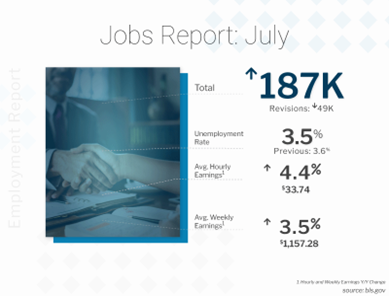
The Bureau of Labor Statistics (BLS) reported that there were 187,000 jobs created in July, which was weaker than estimates. Job growth in May and June was also revised lower, subtracting 49,000 jobs in those months combined. The unemployment rate fell from 3.6% to 3.5%.
What’s the bottom line? The headline job number comes from the report’s Business Survey, which is based predominantly on modeling and estimations. In fact, one of the biggest reasons we saw job gains last month was the birth/death model, where the BLS estimates new business creation relative to closed businesses and how many jobs this created. In July, this modeling added 280,000 jobs but it’s hard to believe that many businesses were started last month in the current economic climate, especially given the cost of capital.
Job gains are clearly slowing, as job growth in June (185,000) and July (187,000) were the two lowest levels reported since December 2020. Plus, a deeper look at the data shows that part-time workers increased by 972,000, while multiple job holders rose by 118,000, meaning some people are having to pick up second jobs to get by. Full-time workers also fell by 585,000.
Average weekly hours also declined slightly, which is important because one of the ways businesses cut costs is to cut the number of hours worked. This caused average weekly earnings, which is a good reflection of take-home pay, to only increase 0.1% from June.
Overall, this data suggests underlying weakness in the job market and economy in general.